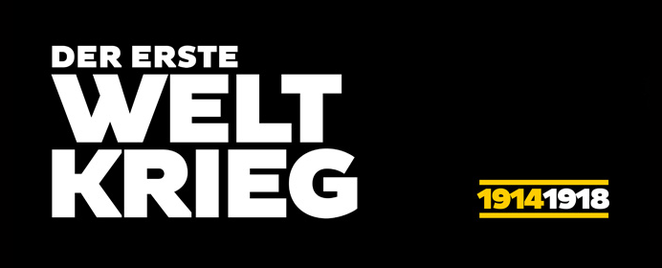Orientation

The exhibition "1914–1918. The First World War" offers an overview of the events of the First World War and their contexts as seen in a broad European and global perspective. On the basis of 14 representative places – specific battle sites such as Verdun, Tannenberg or Gallipoli, but also political and cultural centres like Petrograd or Berlin – important stations and situations of the war are examined. Overriding topics such as the global economic war or the worldwide prisoner of war system are presented in separate rooms. At the same time the exhibition provides a personal approach to the events of the First World War: the experiences of contemporaries, to be identified by the yellow markings, are illustrated by means of diaries and other personal objects. Blue-coloured interactive elements explore the degree to which the consequences of the First World War can still be felt in our present times.
[Translate to English:] Den Rahmen der Ausstellung bildet die Zeit unmittelbar vor und nach dem Ersten Weltkrieg.
Context
The scope of the exhibition comprises the time from immediately before until just after the First World War. The entrance area represents the globalised world around the turn of the century when the culture, economies and politics of the European powers and states were closely interlinked throughout the world. The situation in the German Empire represents a typical example of the optimistic view of the future, but at the same time of the political and social tensions in the run-up to the war.
At the end of the tour visitors are confronted with traces the World War has left behind throughout Europe: memorials for the dead, radical changes in the political landscape, but also unresolved conflicts.
Places
A marking on the floor leads visitors through the 14 geographically arranged theme rooms. At the beginning the French river Marne symbolises the shocking experience of the new war in the late summer of 1914. The failure of the German offensive shattered the illusion of a quick conquest and end to the war. The example of the German victory at Tannenberg under General Paul von Hindenburg in August 1914 illustrates the cult that grew up around war heroes as well as the propaganda that was soon steered by the state. The attributes of the industrialised war with its modern techniques of killing and injuring, despite minimal gains of terrain, are demonstrated by such places as Verdun and Ypres as well as by the rivers Somme in northern France and Isonzo in the Julian Alps. The battle sites Gallipoli and German East Africa stand for the global spread of violence and its drastic consequences for the soldiers and civilian populations. Forms of occupation as an aspect of the modern conduct of war are seen in the examples of the Belgian capital Brussels in the west and the Austro-Hungarian towns of Gorlice and Tarnów on the Eastern Front. The Austro-Hungarian region of Galicia stands not only for a decisive military defeat of the Habsburg monarchy in the autumn of 1914, but also for the fear of the “enemy within” in the multi-ethnic states of Europe. Different developments can be seen in the two political and cultural centres Berlin and Petrograd. While the war-weariness of the Russian empire led to revolution and civil war in 1917, the deprivations experienced in Berlin culminated in political upheavals soon thereafter. Finally, the French city of Amiens, an exemplary scene of battle in the last year of the war, illustrates the delusive hopes that all sides had placed in the war and the failure of the last German offensive.
Spheres
The exhibition takes not only specific places, but also global spheres of war as a point of departure. It explores the new methods used in a war that was increasingly conducted at sea and in the air; in a multimedia presentation it examines the global war economy involving the total mobilisation of all resources. Another room is devoted to the system of imprisonment of the soldiers of the defeated armies, which was unprecedented in its territorial and bureaucratic dimensions. Furthermore, another separate area explores the extreme situations that marked the everyday life of the soldiers on the worldwide fronts.
Perspectives
Visitors can get a glimpse of the perspectives on the war felt by individual contemporaries at many different places throughout the exhibition. Personal documents and objects demonstrate the individual approaches to the events and experiences of the war. They provide insight into the way military leaders and politicians, but especially ordinary soldiers and civilians perceived the war. The objects bear witness to deprivation, injury and death, but also to a fascination with the new, industrialised war. Exponents demonstrating these personal levels are highlighted by yellow markings.
[Translate to English:] Irritationen: In der Ausstellung werfen fünf interaktive Stationen irritierende Fragen auf, die ausgehend vom Ersten Weltkrieg einen Bogen bis in die Gegenwart spannen.
Irritations
Five interactive stations in the exhibition pose somewhat provocative questions that form a bridge between the First World War and the present day: What effects did the use of chemical weapons have on the conduct of the war? What traces did the war leave in our languages worldwide? How is the war remembered in the different countries? What role did the peace treaties play in shaping the current structure of the European states?
At the stations, each coloured in blue, visitors can test their knowledge and record their opinions on current issues.